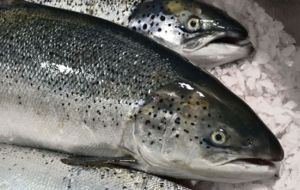MercoPress. South Atlantic News Agency
Chile fisheries landings in five months total 1.6 million tons, up 24%
 Demersal catches overall were down while farmed Atlantic salmon production was up 16.8%
Demersal catches overall were down while farmed Atlantic salmon production was up 16.8% Chile's accumulated fisheries landings during the first five months of the year totaled 1.6 million tons, up 24% from the five months of 2013, when 1.3 million tons were landed.
According to the latest “Fisheries and Aquaculture Sector Report” from Chile's Under Secretariat of Fisheries and Aquaculture (SUBPESCA), the fishing sector contributed 1.1 million tons between January and May 2014.
A majority percentage, 85.6% of landings was composed of pelagic resources while demersal resources accounted for 1.2%; those connected to the southern austral demersal fishery represented 1.1% and other resources completed the remaining 12.1%.
Sardine, anchovy and horse mackerel landings respectively represented 35%, 33.7% and 21.7% of the accumulated capture sector landings until May 2014. These landings were concentrated in Regions V and X (67.1% of the total); in Regions XV to II (28.8%) and in Regions III and IV (4.1%).
As to catches of demersal fisheries, in the five months of this year, a total of 5,945 tons of hake were landed, 3.1% more than in the same period of 2013 (5,765 tons). The main contribution came from the artisanal fleet, with 3,400 tons while industrial vessels landed 2,500 tons.
SUBPESCA also reported that the accumulated landing of hake up to May this year totaled 9,400 tons, 39.5% less than in 2013 (15,520 tons). Chilean sea bass (toothfish) landing was 758 tons, 20.5% less than in the first five months of 2013 (953 tons). Likewise 512 tons of king-clip, compared to 690 tons in the same period last year, that is to say, 25.8% less.
Meanwhile, in the first five months of this year the National Fisheries and Aquaculture Service (SERNAPESCA) reported that aquaculture harvests totaled 477,505 tons, which represents a decrease of 8.5% compared to the same period in 2013 when 522,115 tons were harvested.
The main products were Atlantic salmon, mussels and rainbow trout, which accounted for 51%, 25.7% and 12.3% of the total harvest. Regions X and XI generated most of the harvest: 293,000 tons and 167,200 tons, respectively.
Atlantic salmon harvest was 243,460 tons, 16.8% more than the cumulative volume between January and May 2013 (208,357 tons). Most production was from Regions XI (139,200 tons) and X (91,300 tons). Mussels totaled 123,000 tons, 28.6% less than in the same period in 2013 (172,306 tons). Rainbow trout harvest was 58,600 ton, 13.7% less than the accumulated volume in the same period in 2013 (67,860 tons). (FIS).-




Top Comments
Disclaimer & comment rules-

-

-

Read all commentsIf the Falklands and Chile have had bumper seasons, why has Argentina had a bad one? Corruption perhaps?
Jul 09th, 2014 - 09:50 am 0Actually Chile aquaculture accounted for the increase vs. wild captures being in decrease. Investment climate and good business practices give Chile it's advantage over Argentina.
Jul 09th, 2014 - 12:00 pm 0The fishing stocks are being damaged and tighter catch controls are required.
Jul 09th, 2014 - 12:38 pm 0Very small Reineta coming ashore and no jurel ... not good.
Commenting for this story is now closed.
If you have a Facebook account, become a fan and comment on our Facebook Page!